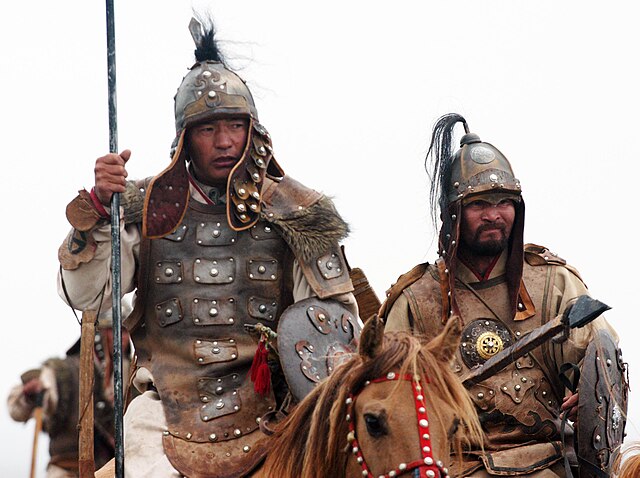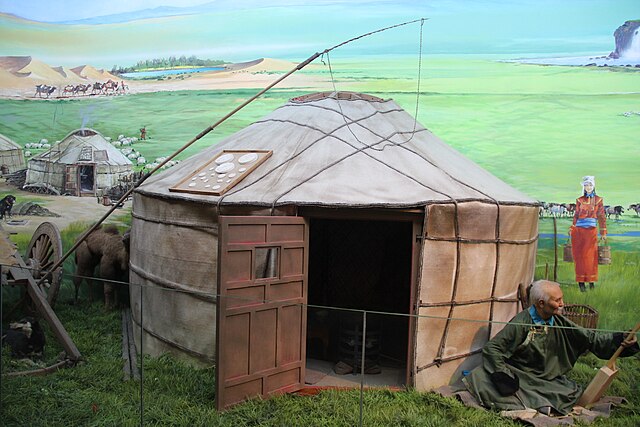The Mongol Empire, which existed during the 13th and 14th centuries CE, is known for being the largest contiguous land empire in history. At its peak, the Mongol Empire stretched from Eastern Europe to the Sea of Japan, covering large swaths of Asia and Eastern Europe. An important aspect that enabled the rise and expansion of this empire was its nomadic people and the pastoral, farming lifestyle they followed.
Overview of the Nomadic Lifestyle
The Mongols originated as a collection of nomadic tribes in the steppes of Central Asia. Their lifestyle revolved around moved from place to place with their herds of livestock, which included horses, sheep, goats, cattle, and camels. This nomadic lifestyle was essential for finding fresh grazing pastures for their animals across the sparse steppe grasslands with low annual rainfall.
Some key aspects of the traditional Mongol nomadic lifestyle included:
- Following predictable seasonal migration routes in search of good pastureland
- Living in portable dwellings like yurts (ger) that could be easily packed up and moved
- Having a diet based on meat and dairy products from their livestock
- Trading animal products, meat, and leather goods in local markets and cities
- Having skilled horsemen due to their reliance on horses for travel and warfare
Despite the lack of a fixed residence, the nomadic Mongol tribes had established territories and grazing lands that they would utilize each season. Their nomadic lifestyle and formidable battle skills on horseback also primed them for the rapid conquests led by Genghis Khan in the early 13th century.

Livestock and Grazing Strategies
The livestock that the Mongols herded played a vital economic role for not only food and nourishment, but also for clothing, shelter, tools, trade, and warfare. As such, maintaining the health and size of their livestock herds was an important consideration in the Mongol nomadic lifestyle.
Some of the key grazing and livestock management strategies included:
Diverse Herd Composition - Mongol herds included different livestock types like horses, sheep, goats, cattle, and camels. This allowed for flexibility depending on the climate and pastureland. Horses were essential for mobility while cattle, sheep and camels provided meat, milk, wool and transport.
Seasonal Migrations - The Mongols would move their mobile pastoral camps and herds large distances between defined summer and winter grazing territories. This followed the growth patterns of the grasslands to utilize the best pastures.
Community Mobility - Pasture access was managed by chieftains and leaders to allow different families and groups to utilize the grasslands effectively through coordination. This organized mobility prevented overgrazing in specific areas.
Stall Feeding - The Mongols would cut grass and hay during summer and store them to provide feed for livestock that were stalled during harsh winters and snow storms. This reserve feed maintained herd health.
Herd Splitting - Large communal herds would be split into smaller more manageable units during grazing. This allowed for supervision, protecting animals from theft, controlling breeding, and preventing infighting.
Through these adaptive methods, the nomadic Mongol pastoralists supported large livestock numbers in equilibrium with the pasturelands. This in turn led to considerable wealth and military might based on the extensive animal herds.

Military Advantages
The Mongol Empire was known for its ruthless military efficiency as it rapidly expanded its territories under the leadership of Genghis Khan and his descendants. There were some unique military advantages stemming directly from the Mongol nomadic lifestyle and animal husbandry skills:
Cavalry Forces - Mongol boys learned expert horsemanship and archery skills from a young age by tending and managing horses. This produced a strong cavalry that could efficiently coordinate and fight battles.
Animal Hardiness - The hardy steppe horses and livestock that the Mongols bred were adapted for long journeys with stamina and strength. This enabled extended campaigning and travel.
Mobility - The nomadic lifestyle meant all resources were transportable. Coupled with hardy horses, Mongol soldiers could travel up to 90 km per day allowing lightning raids.
Sustenance - Mongol warriors traveling with traditional diets of meat and dairy products did not rely heavily on fragile supply chains that most sedentary armies depended on. This reduced risk and extended reach.
These advantages led Mongol armies to successfully utilize tactics like ambushing, feigned retreats, and progressive battles that wore down opponents across vast distances. With skilled cavalry and hardy livestock combined with great mobility and sustenance, they could execute complex strategic maneuvers that most contemporary forces could not match.

Agricultural and Foraging Practices
While the Mongol economy and lifestyle focused on extensive animal herding, traditional agricultural and foraging practices also occurred. Some key examples include:
Limited Agriculture
- Growing millet, barley, oats and some wheat for additional food
- Maintaining small garden plots near campsites and watering holes
- Agricultural labor done by women, children and the elderly
Foraging
- Gathering roots, wild onions, garlic and mushrooms from the surrounding steppes
- Hunting small game like hares, marmots and deer for meat and fur
- Fishing along rivers and streams crossed during migrations
- Collecting honey from wild bee colonies nestled in hollow trees
Food Preservation
- Drying and salting meat to preserve it as winter provisions
- Fermenting mare’s milk into airag (a mildly alcoholic drink)
- Making yogurt and cheese from cattle, sheep and goat milk
These supplemental food sources provided vital nutrition and variety in the traditional Mongol diet. It also enabled preservation during harsh winters and added trade items.

Impacts and Legacy
While the great Mongol Empire eventually fragmented into smaller kingdoms and tribes, the legacy of the Mongol conquests under Genghis Khan and his successors left an enduring impact across Asia and Europe. Some of the key impacts included:
- Facilitated trade, cultural exchange and technology transfer along the Silk Road between Eastern and Western civilizations
- Enabled the spread of unique religious beliefs, cuisine, fashion and languages across different regions
- United territories were religious freedoms were provided leading to stable prosperous domains
- Left behind advanced military strategy principles and weapons technology innovations
- Many counties influenced by enduring administrative and bureaucratic governance systems
Importantly, the exceptional strategic mobility and formidable fighting skills that allowed the Mongols to establish history’s largest contiguous land empire stemmed from the hardy lifestyle of the nomadic pastoral tribes people native to the Central Asian steppes. The livestock husbandry skills, diets, equestrian talent and battle readiness that arose from generations of animal herding and nomadic migration ultimately catalyzed the emergence of this mighty empire.
Even as modern infrastructure and technology has led more Mongol groups to adopt sedentary lifestyles, there is still a rich minority that follows the traditional nomadic way - migrating across the remote grasslands with their livestock. This ancient practice of pastoral nomadism continues to be passed down through generations and serves as a living reminder of the historical foundations that once led to the formidable Mongol Empire covering over 33 million square kilometers at its peak.

Frequently Asked Questions
What livestock did the Mongols herd?
The Mongols herded horses, sheep, goats, cattle, and camels across the Central Asian steppes. Of these, horses were especially essential for mobility and warfare. Sheep, cattle and camels provided the bulk of meat, wool and transport needs.
How many horses did each Mongol family own?
Wealthy families had horse herds ranging from 20 to several hundred horses. The average pastoral family owned around 50-100 horses which could be drawn from communal herds during migration, fighting and hunting.
What did the Mongols use sheep and goats for?
Sheep and goats served as the primary source of meat and dairy for the traditional Mongol diet. Wool from sheep was used to make clothes, rugs and insulating covers for the portable yurt homes. Goats also provided hides for leather and transported goods.
Why were cattle less common than other livestock for Mongols?
Compared to hardy sheep and goats, cattle require more water and are less mobile. So they were not as well suited for migration across the arid grasslands. But cattle were valued for their milk and dairy products which formed staples of the Mongol diet.
What modern countries and regions was the Mongol Empire centered around?
At its peak, the Mongol Empire centered around modern-day Mongolia, China, Central Asia, Russia, Eastern Europe, and the Middle East. It encompassed the Silk Road regions bridging Asia and Europe.
Sure, here are some additional sources from Britannica and Wikipedia:
“Mongol.” Encyclopædia Britannica, Encyclopædia Britannica, Inc., https://www.britannica.com/topic/Mongol. Accessed 12 Dec 2022.
“Mongol Empire.” Wikipedia, Wikimedia Foundation, 11 Dec. 2022, https://en.wikipedia.org/wiki/Mongol_Empire. Accessed 12 Dec 2022.
“Nomad.” Encyclopædia Britannica, Encyclopædia Britannica, Inc., https://www.britannica.com/topic/nomadism. Accessed 12 Dec 2022.
“Pastoralism.” Wikipedia, Wikimedia Foundation, 3 Dec. 2022, https://en.wikipedia.org/wiki/Pastoralism. Accessed 12 Dec 2022.
“History of Mongolia.” Wikipedia, Wikimedia Foundation, 7 Dec. 2022, https://en.wikipedia.org/wiki/History_of_Mongolia. Accessed 12 Dec 2022.
Sources
“History of Mongolia.” Wikipedia, Wikimedia Foundation, 7 Dec. 2022, https://en.wikipedia.org/wiki/History_of_Mongolia. Accessed 12 Dec 2022.
“Mongol.” Encyclopædia Britannica, Encyclopædia Britannica, Inc., https://www.britannica.com/topic/Mongol. Accessed 12 Dec 2022.
“Mongol Empire.” Wikipedia, Wikimedia Foundation, 11 Dec. 2022, https://en.wikipedia.org/wiki/Mongol_Empire. Accessed 12 Dec 2022.
“Nomad.” Encyclopædia Britannica, Encyclopædia Britannica, Inc., https://www.britannica.com/topic/nomadism. Accessed 12 Dec 2022.
“Pastoralism.” Wikipedia, Wikimedia Foundation, 3 Dec. 2022, https://en.wikipedia.org/wiki/Pastoralism. Accessed 12 Dec 2022.
Di Cosmo, Nicola, and Don J. Wyatt, editors. Political Frontiers, Ethnic Boundaries and Human Geographies in Chinese History. Psychology Press, 2003.
Rogers, J. Daniel, et al. “An Introduction to the Environmental History of the Mongol Empire.” History Compass, vol. 11, no. 2, 2013, pp. 189–198.